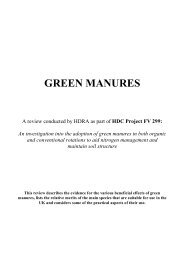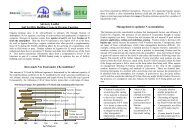A review of leguminous fertility-building crops, with particular ...
A review of leguminous fertility-building crops, with particular ...
A review of leguminous fertility-building crops, with particular ...
You also want an ePaper? Increase the reach of your titles
YUMPU automatically turns print PDFs into web optimized ePapers that Google loves.
A <strong>review</strong> <strong>of</strong> <strong>leguminous</strong> <strong>fertility</strong>-<strong>building</strong> <strong>crops</strong>, Defra project OF0316 1. Introduction<br />
1. INTRODUCTION<br />
1.1. What are ‘<strong>fertility</strong>-<strong>building</strong> <strong>crops</strong>’?<br />
Nitrogen can be imported onto organic farms by several routes (Table 1). However, the<br />
cornerstone <strong>of</strong> the organic philosophy is the use <strong>of</strong> legume based leys to build <strong>fertility</strong>.<br />
Indeed, the organic standards require the inclusion <strong>of</strong> legumes in the rotation. Fertility<strong>building</strong><br />
<strong>crops</strong> and green manures are therefore key components <strong>of</strong> organic rotations.<br />
However, the regulations contain no specific requirements for ley management and the<br />
paucity <strong>of</strong> research means that their management is <strong>of</strong>ten based on hearsay rather than<br />
empirical evidence. Management options for these <strong>crops</strong> are many, including:<br />
• choice <strong>of</strong> species and cultivar;<br />
• length <strong>of</strong> growing period <strong>with</strong>in the rotation;<br />
• rotational position and management <strong>of</strong> foliage (cutting and exporting, cutting and<br />
mulching, grazing or combinations <strong>of</strong> these).<br />
Table 1.1. Typical sources and loss pathways for nitrogen in organic farming<br />
• Fixation <strong>of</strong> atmospheric N<br />
• Purchased feed stuffs<br />
• (Cover <strong>crops</strong>)<br />
• Imported manures/composts<br />
• Rainfall<br />
Sources Losses<br />
• Nitrate leaching<br />
• Ammonia volatilisation<br />
• N2 and (NOx) emissions<br />
• Crop/animal produce<br />
• Exported manures<br />
Typical <strong>crops</strong> under UK conditions include red clover, white clover, vetch, lucerne, sanfoin,<br />
grass/clover leys (white clover/perennial ryegrass or red clover/Italian ryegrass), peas and<br />
beans. Lupins and soya are also being used in southern Britain. Recent work in NE England<br />
has indicated that two new legumes may also be suitable: lentil (Lens culinaris Medik.) and<br />
pinto bean (Phaseolus vulgaris).<br />
1.2. Role in rotations<br />
Organic farming aims to be self-sufficient in nitrogen through fixation <strong>of</strong> atmospheric N2,<br />
recycling <strong>of</strong> crop residues and application <strong>of</strong> internally sourced manure. As well as legume<br />
based leys, organic rotations also <strong>of</strong>ten include a supplementary boost <strong>of</strong> N during the<br />
<strong>fertility</strong> depleting phase by growing a <strong>leguminous</strong> crop, such as field beans or peas.<br />
However, it is the legume-based ley that is the most important element <strong>of</strong> <strong>fertility</strong>-<strong>building</strong>.<br />
A major objective in the application <strong>of</strong> <strong>fertility</strong>-<strong>building</strong> <strong>crops</strong> (including green manures) is<br />
to provide the N required for optimal performance <strong>of</strong> the subsequent exploitative <strong>crops</strong> in the<br />
rotation (Watson et al., 2002). Nitrogen is usually the limiting nutrient in organic systems,<br />
<strong>particular</strong>ly in the later stages <strong>of</strong> the rotation, as the N supply from <strong>fertility</strong>-<strong>building</strong> <strong>crops</strong><br />
declines. If organic farmers are to optimise the capture and use <strong>of</strong> this nutrient, they require a<br />
reliable estimate <strong>of</strong> the amount <strong>of</strong> N available and its pattern <strong>of</strong> release.<br />
Supply <strong>of</strong> N to the following <strong>crops</strong> relies on mineralisation <strong>of</strong> the residues that have been<br />
accumulated during the <strong>fertility</strong>-<strong>building</strong> phase. Captured N can also be returned to the soil<br />
Written by S Cuttle, M Shepherd & G Goodlass Page 14




